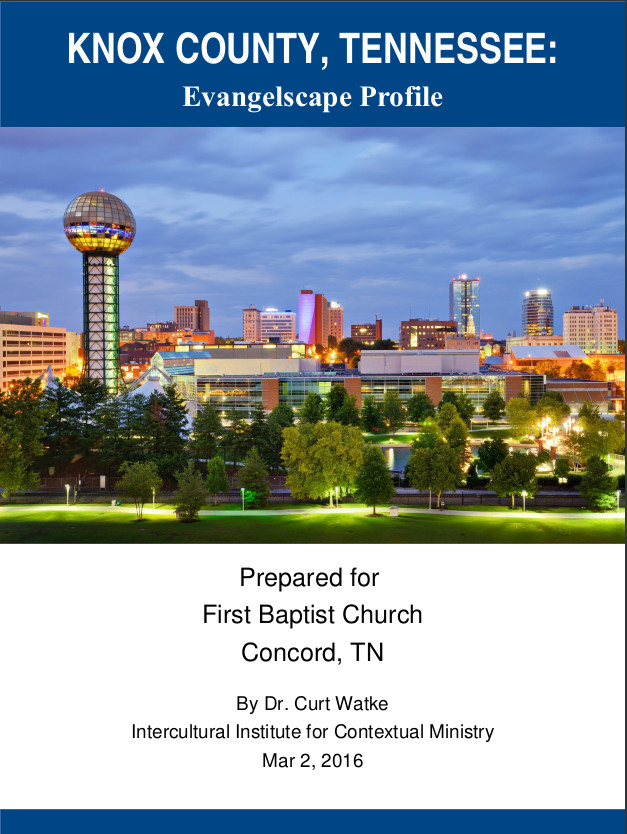Knox County, Tennessee Evangelscape Profile
As ministry leaders in Knoxville, Tennesse reviewed the Barna Group information that stated that Knoxville was one of the most "Bible-minded" cities in the United States, they couldn't help but wonder about the disparity between Barna's claims and the actual state of the church they experienced. Some cited a report that 98% of the Knoxville population were "Christian." Is this true? If so what are the ramifications? If not, what is the real "truth." Using data analytics, we provided an analysis of Knox County that described the reality of religious affiliation and religious active participation in terms of the "nones," the "dones," and the non-Christian population.
Process
This proposal recognized that several different sources of information should be used to provide a cluster of variables that would speak to the overall situation. The report that was created included maps, tables, and text that explain various dimensions of religious affiliation and participation for the county and was displayed at the block group and census tract levels. The data for the project included the following (other data included applied statistical modeling and data analytics):
WHERE DO ALL THE NUMBERS COME FROM?
- American Community Survey, Census Bureau
- Knox County Tennessee, Congregational Membership Data, RCMS
- Knox County Tennessee, Church Attendance Data, The American Church
- Church Statistics, Center for Applied Research in the Apostolate, Georgetown University.
Applied Statistical Modeling and Data Analytic
- Standard data analytic approaches were used to estimate affiliation, active participation, the Dones (those who are affiliated by not active), the Nones
(the population that are not affiliated) for small geographical areas at the census tract layer. - Statistical validity was ascertained at 85-90% accuracy based on testing analytic models to known values.
GIS Modeling was Performed on the Data
- Thematic maps show the population estimates for religious affiliation, active
participation, the Dones and the Nones across the census tracts within Knox County.
WHAT IS INCLUDED IN THE REPORT?
– Thematic Maps & Data Tables
- Religious Affiliation
- Religious Active Participation
- The “None” Population
- The “Done” Population
- The “Non-Christian” Population
– Brief Description /Explanations
– Issues for Consideration
Download the Report

Process
This proposal recognized that several different types of information should be used to provide a cluster of variables that will speak to the overall situation. The report that was created included maps, tables, and text that explain various dimensions of community data at the county and/or place geographies. The data for the project included the following (other data was added as the project is developed, also see separate section for Hispanic analysis below):
Population data
- Estimated population change from 2010 to 2014
- Projected population change from 2013 to 2025
- Population density per square mile
- et international migration from 2010 to 2014 for CBSAs and/or CSAs and possibly counties
- Net domestic migration from 2010 to 2014 for CBSAs and/or CSAs and possibly counties
- Total net migration from 2010 to 2014 for CBSAs and/or CSAs and possibly counties
Geographic data
- Various configurations of regional areas based on internal KNCSB data, FCC and census designations including metropolitan and micropolitan areas, and core based statistical areas.
- Location of urbanized areas across the state along with population density
- Percent urban and rural for each county along with their respective rural-urban continuum, urban influence, economic dependence, and persistent poverty codes.
- Geographic mobility patterns by county and across regional areas
Economic patterns
- Unemployment rate along with types of employment and median household income
- An overview of three types of poverty and two types of working poor across geographies with a per capita and household income analysis
- An analysis of rural to urban commuting patterns to establish commerce flows
- Percentages of people in occupational categories across various configurations of regional areas
- Average weekly wages by county and averaged across various configurations of regional areas
- Aggregate household income in metropolitan and micropolitan areas, and core based statistical areas
- Aggregate household income by age of householder, by types of income including retirement, public assistance, etc.
- Shares of aggregate household income by quintile ranges
Religious evaluation
- Analysis of mission site locations relative to various configurations of regional areas
- Analysis of extent of adherents and attendance in evangelical, mainline protestant and catholic churches along with estimated SBC presence within geographical areas
Hispanic Analysis
An analysis of the Hispanic population across the state of Nebraska will be completed that uses various demographic, economic, immigration and business pattern data to determine the best positioning of a future CPC. Data included:
Population data
- Population totals and trends
- Age groups and median age
- Countries of origin
- Nativity, citizenship status and year of entry
- Language use and extent of English ability
- Family type and marital status
- School enrollment and educational attainment
- Income levels and poverty status
Geographic data
- Geographic mobility patterns by county and across regional areas
- Population density by county and across regional areas
Economic patterns
- Types of employment, occupations and median household income
- Poverty status of Hispanic populations
- Per capita and aggregate income patterns
- Means of transportation to work
